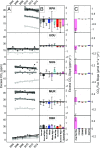Long-term urban carbon dioxide observations reveal spatial and temporal dynamics related to urban characteristics and growth
- PMID: 29507190
- PMCID: PMC5866532
- DOI: 10.1073/pnas.1702393115
Long-term urban carbon dioxide observations reveal spatial and temporal dynamics related to urban characteristics and growth
Abstract
Cities are concentrated areas of CO2 emissions and have become the foci of policies for mitigation actions. However, atmospheric measurement networks suitable for evaluating urban emissions over time are scarce. Here we present a unique long-term (decadal) record of CO2 mole fractions from five sites across Utah's metropolitan Salt Lake Valley. We examine "excess" CO2 above background conditions resulting from local emissions and meteorological conditions. We ascribe CO2 trends to changes in emissions, since we did not find long-term trends in atmospheric mixing proxies. Three contrasting CO2 trends emerged across urban types: negative trends at a residential-industrial site, positive trends at a site surrounded by rapid suburban growth, and relatively constant CO2 over time at multiple sites in the established, residential, and commercial urban core. Analysis of population within the atmospheric footprints of the different sites reveals approximately equal increases in population influencing the observed CO2, implying a nonlinear relationship with CO2 emissions: Population growth in rural areas that experienced suburban development was associated with increasing emissions while population growth in the developed urban core was associated with stable emissions. Four state-of-the-art global-scale emission inventories also have a nonlinear relationship with population density across the city; however, in contrast to our observations, they all have nearly constant emissions over time. Our results indicate that decadal scale changes in urban CO2 emissions are detectable through monitoring networks and constitute a valuable approach to evaluate emission inventories and studies of urban carbon cycles.
Keywords: carbon dioxide; emissions; greenhouse gas; trends; urban.
Conflict of interest statement
The authors declare no conflict of interest.
Figures




References
-
- International Energy Agency . World Energy Outlook 2008. International Energy Agency; Paris: 2008.
-
- Pataki DE, et al. Urban ecosystems and the North American carbon cycle. Glob Change Biol. 2006;12:2092–2102.
-
- Hutyra LR, et al. Urbanization and the carbon cycle: Current capabilities and research outlook from the natural sciences perspective. Earths Future. 2014;2:473–495.
-
- Ackerman KV, Sundquist ET. Comparison of two U.S. power-plant carbon dioxide emissions data sets. Environ Sci Technol. 2008;42:5688–5693. - PubMed
-
- NRC . Verifying Greenhouse Gas Emissions: Methods to Support International Climate Agreements. National Academies Press; Washington, DC: 2010.
Publication types
LinkOut - more resources
Full Text Sources
Other Literature Sources

